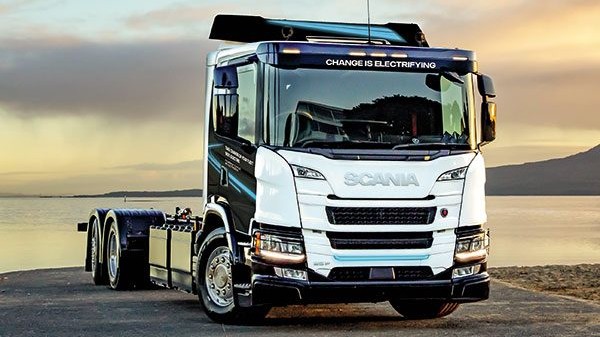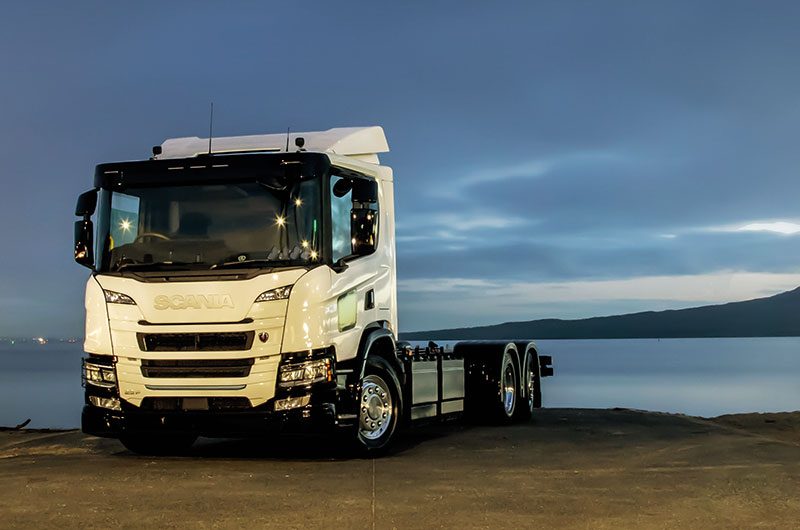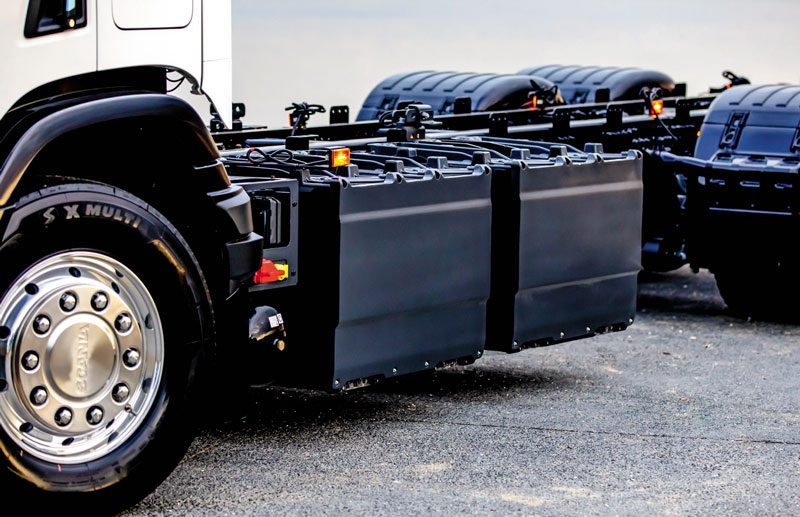
Scania New Zealand has unveiled its first fully electric truck, one of two currently in the country. The company is bullish about its commitment to sustainability and its end-of-decade goals – and this is where it starts.
Scania New Zealand is the first European OEM to introduce electric trucks to New Zealand. According to managing director Rafael Alvarenga, the move is not a one-off but a genuine factory-led solution to sustainable transport in Aotearoa by the current heavy-truck segment leader.
“Irrespective of the growth of the business, by 2025, Scania has a global goal to achieve a 20% reduction [compared with 2015] in carbon emissions of its produced vehicles. By that date, electrified vehicles will account for 10% of its total sales worldwide – increasing to 50% by 2030,” says Alvarenga, who adds that Scania New Zealand’s goals align with these targets.
“In 2019, Scania committed to science-based targets and to look at emissions in its industrial and commercial operations, as well as the emissions from its vehicles – those accounting for more than 90% of its total carbon emissions,” he says. “Last year, Scania signed a climate pledge to reach net-zero carbon emissions by 2040.”

The company has begun its EV journey with two first-generation battery-electric 25P 6×2 trucks. They weigh in at 29 tonnes (GCVW) and are available with the option of either five or nine batteries – totalling 165kWh or 300kWh. Each has a range of up to 250km and is suitable for short- or medium-haul journeys.
The 25P is currently the only electric truck in this weight class in New Zealand.
One battery pack is mounted beneath the cab between the chassis rails where the engine would traditionally be found (as we’ve become accustomed to with electric trucks) and there are two additional battery packs on either side of the chassis rails behind the steer axle. The company has paid particular attention to side- impact protection – the side-mounted battery packs are surrounded by a sturdy frame and an outward-facing impact guard.
The compact electric motor sits between the chassis rails and drives the first rear axle via a conventional driveshaft and differential. Importantly, the motor has an inbuilt two-speed transmission to provide high power over a wider speed span – undoubtedly improving driveability. The electric motor delivers maximum continuous power of 230kW (310hp) and peak power of 295kW (395hp). Maximum continuous torque is 1300Nm, with a peak of 2200Nm.
A 60kW electronic power take-off is installed, and the trucks are designed to allow for optional emission-free operation of hydraulics and refrigeration units.
“We spent a lot of time preparing the right vehicle for the application, looking at our network and workshops, parts supply, competencies and training. And also at other stakeholders like towing companies, certified body-builders and the customers. We needed to get the whole ecosystem to understand it. It’s a different product that needs to be handled correctly,” Alvarenga says.
He says customers understand there is an environmental problem and they need to act. “Acquiring an electric truck is not just an investment in the customer’s fleet, but also in their brand and market. An electric truck enables the customer to stay ahead of the competition, learn about infrastructural challenges, and adapt to the future.
“The first target [10% by 2025] is always the hardest. You need to work with the early adopters – they’re few, and you need to find the right ones. With this truck, we can have really good discussions.”
With that in mind, Auckland’s Reliance Transport bought the two initial trucks as part of the second stage of the company’s Project SWITCH, which is expected to be operational later this year.
Reliance already operates four electric vans and an electric reach-stacker – and trucks are the next step. “We’re moving to become a zero-emission transport business. To start, we’re placing Euro-6 trucks into the fleet and converting to electric where we can. Medium-range trucks are ideal for electric power at the moment, so that’s what we’re starting with,” says general manager Mark Darrah.
“We wanted an OEM- supplied truck with factory backing. With support from Scania and EECA, we’re starting the journey,” he says.
“It’s a more efficient way to operate. It comes down to dollars and cents – the maths makes it worth doing.
“It’s irrelevant whether you like it or not… The truck manufacturers are transitioning.”
Alvarenga explains that as these early trucks enter the market, Scania is taking a customer-first approach to charging, helping to manage solutions at depots, final destination, workshops and other areas specific to the customer. “But when you have trucks running everywhere, on different routes, we need the public and private sectors. We’re seeing that beginning already.”
According to Alvarenga, diesel will remain an important part of the future journey while the development of alternatives continues. “The new Super powertrain is coming to New Zealand next year. It promises 8% better fuel economy and will help bridge the gap with emissions and efficiency.”
Regarding alternative power, Scania is looking closely at all technologies available today, including biofuels and hydrogen. However, the company remains adamant that none of these will have a greater long-term impact than electrification. Globally, Scania has committed to launching at least one new electric product application every year.
“Hydrogen is a hot topic, but direct electric drive provides better total efficiency of around 70%. Scania globally always looks at the efficiency of all systems, and is still looking at the role of hydrogen in the overall ecosystem. It’s not a one-fits-all. But we strongly believe direct battery electric is the right way.”
Alvarenga anticipates that more electric trucks will be arriving in New Zealand soon. According to Scania, New Zealand was selected as one of the first markets outside of Europe to launch this model because of the country’s promotion of and access to renewable energy, the unique application of these vehicles, as well as Scania New Zealand’s rise to market-leading status.
“Scania’s global aim is to drive the shift towards a sustainable transport solution, creating a world of mobility that is better for business, society and the environment. This is also our aim locally in New Zealand,” says Alvarenga.

TEAMING UP TO DRIVE SUSTAINABILITY
In May 2020, Scania New Zealand established its business transformation team, a new department responsible for planning and actioning sustainably alongside day-to-day operations.
The department is headed up by Rob Covich, who has taken on the role of business transformation director, moving from his previous performance director role.
“This new department is all about supporting the business’ journey to transform and prepare for the sustainable future of our industry. Globally, Scania is moving into a transformation journey and adapting to the changing business landscape. I am proud to be leading Scania New Zealand’s efforts towards this goal,” Covich says.
The department has four main areas of focus. The first is performance, focusing on driver services, fleet care and connected service to reduce the fuel consumption and drive efficiency of Scania vehicles on the road today.
The second is digitalisation. Information development will continue to play an important role in creating efficiencies. Scania says its ongoing development of technology platforms and access to available data will be critical in helping customers maximise their businesses. “With a lot of the data available today helping us bring new services and products to market, we can eliminate a lot of waste in the transport system,” Alvarenga says.
The third area is the focus on ‘driving the shift’. This guides the development of new vehicle platforms and technologies for introduction into the New Zealand market. “We are prepared to bring new technologies to New Zealand and ready to deliver the services that go along with them,” says Alvarenga.
Finally, network development: “With our growth in New Zealand and the new technologies, we need to make sure that we have the proper network in future, and the decisions and actions need to start right now,” Alvarenga says.












